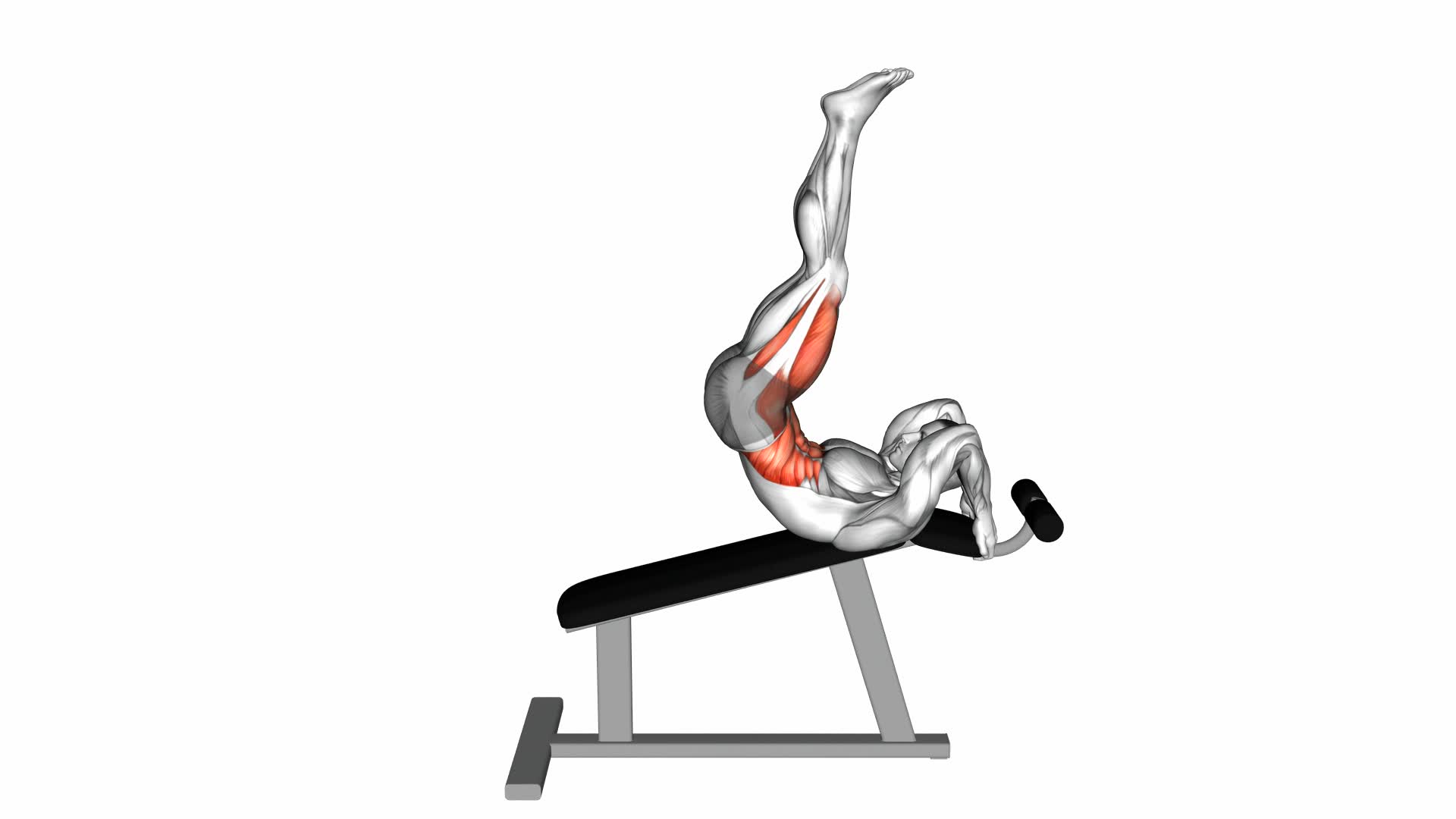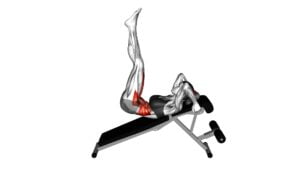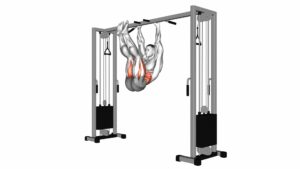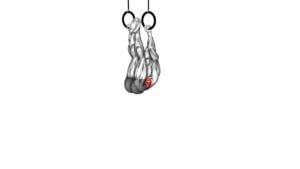Incline Leg Hip Raise (Leg Straight) – Video Exercise Guide & Tips

Are you looking for an effective exercise to target your hip muscles? Look no further than the incline leg hip raise.
Watch This Exercise Video
This video exercise guide will show you the proper form and technique for performing this exercise. With just a few simple tips, you can increase the intensity of your workout and avoid common mistakes.
Get ready to feel the burn and strengthen your hips with this challenging exercise.
Key Takeaways
- Incline Leg Hip Raise increases core strength and stability.
- It targets core muscles, including abs, obliques, and lower back.
- It improves hip mobility and flexibility.
- It strengthens hip muscles, such as hip flexors and glutes.
Benefits of the Incline Leg Hip Raise
You will experience increased core strength and stability by incorporating the incline leg hip raise into your exercise routine. This exercise specifically targets your core muscles, including your abs, obliques, and lower back. By performing the incline leg hip raise, you engage these muscles to stabilize your body and lift your legs against gravity.
The incline leg hip raise also improves hip mobility. As you raise your legs, you're stretching and strengthening the muscles surrounding your hips, such as your hip flexors and glutes. This can help alleviate tightness and improve your range of motion in daily activities and other exercises.
To perform the incline leg hip raise, start by lying flat on your back on an incline bench. Place your hands on the sides of the bench for support. Lift your legs off the bench, keeping them straight and together. Slowly raise your legs towards the ceiling, using your core muscles to lift and control the movement. Pause at the top and then slowly lower your legs back down to the starting position.
Incorporate the incline leg hip raise into your workout routine to strengthen your core and improve hip mobility.
Equipment Needed for the Exercise
To properly perform the incline leg hip raise, you'll need the following equipment.
The main piece of equipment required for this exercise is an incline bench. This bench is specifically designed to allow you to perform exercises at an incline, which helps target different muscle groups.
There are different types of incline benches available, ranging from adjustable ones that allow you to change the angle of the incline, to fixed ones that have a set angle. You can choose the type of bench that best suits your needs and preferences.
If you don't have access to an incline bench, you can use alternative options such as an exercise ball or a step platform. These alternatives can provide a similar incline and still allow you to perform the exercise effectively.
Now that you know the equipment needed for the incline leg hip raise, let's move on to discussing the proper form and technique for this exercise.
Proper Form and Technique for the Exercise
To perform the incline leg hip raise with proper form and technique, focus on engaging your core muscles throughout the exercise. This will help you maintain stability and control as you lift your legs.
Here are some tips to ensure you're performing the exercise correctly:
- Lie face-up on an incline bench with your legs straight and your hands gripping the bench for support.
- Keep your legs together and extend them straight up towards the ceiling.
- Slowly lower your legs back down towards the bench, stopping just before your feet touch.
- Avoid using momentum to lift your legs. Instead, use your abdominal muscles to lift and control the movement.
- Remember to breathe steadily throughout the exercise, exhaling as you lift your legs and inhaling as you lower them.
Common mistakes to watch out for include arching your lower back or letting your legs swing. These errors can put unnecessary strain on your back and decrease the effectiveness of the exercise.
Tips to Increase the Intensity of the Workout
To increase the intensity of the workout, focus on incorporating additional resistance or variations into your incline leg hip raise routine. One way to challenge yourself is by trying advanced variations of the exercise. Instead of keeping your legs straight, you can try bending your knees and bringing them towards your chest as you lift your hips off the bench. This variation engages your core muscles even more and adds an extra level of difficulty to the exercise.
Another way to increase the intensity is by incorporating resistance bands into your routine. Attach one end of a resistance band to the bench and the other end to your ankles. As you raise your legs, the resistance from the band will make the exercise more challenging and help to strengthen your hip muscles.
By adding these advanced variations and resistance bands to your incline leg hip raise routine, you can effectively increase the intensity of your workout. This won't only help to build strength and tone your muscles, but also provide you with a greater challenge and variety in your exercise routine.
Now that you know how to increase the intensity of your incline leg hip raise workout, let's move on to the next section where we'll discuss common mistakes to avoid during the exercise.
Common Mistakes to Avoid During the Exercise
Avoiding common mistakes during the incline leg hip raise exercise is crucial for maximizing its effectiveness and preventing injury. To ensure proper form and get the most out of this exercise, be mindful of the following:
- Not engaging the core: It's important to activate your core muscles throughout the entire movement. This helps stabilize your body and prevents excessive strain on the lower back.
- Lifting the legs too high: While it may be tempting to raise your legs as high as possible, lifting them too high can put unnecessary stress on your lower back. Instead, focus on maintaining a controlled and smooth movement.
- Allowing the lower back to arch: Keep your lower back flat against the bench or floor throughout the exercise. Arching the lower back can lead to discomfort and increases the risk of injury.
- Using momentum: Avoid swinging or using momentum to lift your legs. This takes away from the effectiveness of the exercise and puts strain on the hip flexors rather than targeting the abs.
- Neglecting proper breathing: Remember to breathe in as you lower your legs and exhale as you raise them. Proper breathing technique helps maintain stability and enhances the mind-muscle connection.
Frequently Asked Questions
How Many Repetitions Should I Do for the Incline Leg Hip Raise Exercise?
To determine the number of repetitions for the incline leg hip raise exercise, consider your fitness level and goals. Start with 8-12 reps per set and gradually increase as you get stronger.
This exercise targets your glutes, hamstrings, and core, helping to strengthen and tone these areas. Remember to maintain proper form, avoid arching your back, and engage your core throughout the movement.
Can I Perform the Incline Leg Hip Raise Exercise Without Any Equipment?
Yes, you can perform the incline leg hip raise exercise without any equipment.
This exercise is a great way to target your lower abdominal muscles and improve core strength.
By lying on an inclined bench and lifting your legs straight up, you engage your hip flexors and lower abs.
It's a challenging exercise that can be modified by bending your knees or adding resistance.
Give it a try to add variety to your workout routine.
How Long Should I Rest Between Sets of the Incline Leg Hip Raise Exercise?
To maximize the effectiveness of the incline leg hip raise exercise, it's important to give yourself adequate rest time between sets. Resting for about 30 to 60 seconds allows your muscles to recover and ensures proper form for the next set.
During this rest period, focus on deep breathing to oxygenate your muscles and promote relaxation. Taking the time to rest and breathe will help you perform the exercise more efficiently and prevent fatigue.
Are There Any Modifications or Variations of the Incline Leg Hip Raise Exercise?
When it comes to the incline leg hip raise exercise, there are several modifications and variations you can try. These can help you target different muscles and add variety to your workout routine.
Some modifications include using resistance bands or ankle weights to increase the intensity, or performing the exercise on a stability ball for added core engagement.
Additionally, you can try variations like the single-leg hip raise or the hip raise with knee tucks to challenge yourself even more.
Can the Incline Leg Hip Raise Exercise Help With Improving Core Strength?
The incline leg hip raise exercise can definitely help improve your core strength. By engaging your abdominal muscles, it works to stabilize your body and strengthen your core.
It also targets your hip flexors and glutes, helping to improve overall lower body strength.
To perform it correctly, lie on an incline bench with your legs straight and slowly raise your legs until they're perpendicular to the floor. Remember to maintain proper form and technique throughout the exercise.
Conclusion
In conclusion, the incline leg hip raise is a highly effective exercise for targeting the muscles in your hips and lower abdominal region. By following the proper form and technique, and incorporating tips to increase the intensity, you can maximize the benefits of this exercise.
Avoiding common mistakes will ensure that you're performing the exercise correctly and getting the most out of your workout.
Incorporate the incline leg hip raise into your routine for stronger, more defined hips and abs.

Author
Years ago, the spark of my life’s passion ignited in my mind the moment I stepped into the local gym for the first time. The inaugural bead of perspiration, the initial endeavor, the very first surge of endorphins, and a sense of pride that washed over me post-workout marked the beginning of my deep-seated interest in strength sports, fitness, and sports nutrition. This very curiosity blossomed rapidly into a profound fascination, propelling me to earn a Master’s degree in Physical Education from the Academy of Physical Education in Krakow, followed by a Sports Manager diploma from the Jagiellonian University. My journey of growth led me to gain more specialized qualifications, such as being a certified personal trainer with a focus on sports dietetics, a lifeguard, and an instructor for wellness and corrective gymnastics. Theoretical knowledge paired seamlessly with practical experience, reinforcing my belief that the transformation of individuals under my guidance was also a reflection of my personal growth. This belief holds true even today. Each day, I strive to push the boundaries and explore new realms. These realms gently elevate me to greater heights. The unique combination of passion for my field and the continuous quest for growth fuels my drive to break new ground.







